| |
|
Baptistery of San Giovanni
|
|
|
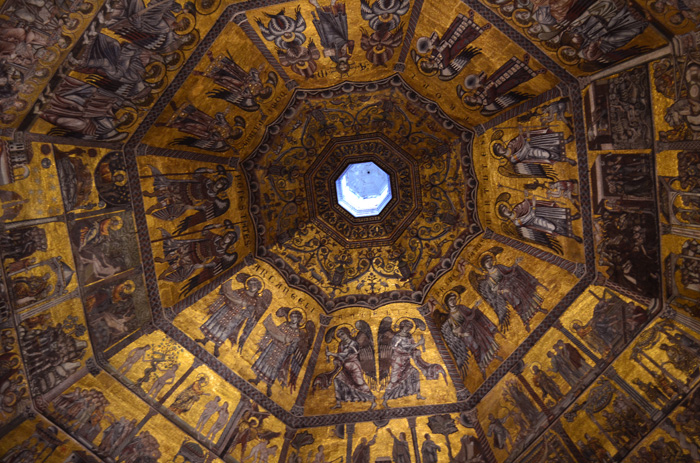 |
Mosaic ceiling
|
History
Early history
|
|
|
For a long time, it was believed that the Baptistry was originally a Roman temple dedicated to Mars, the tutelary god of the old Florence.[3] The unscholarly chronicler Giovanni Villani reported this medieval Florentine legend in his fourteenth-century Nuova Cronica on the history of Florence.[4] However, twentieth-century excavations have shown that there was a first-century Roman wall running through the piazza with the Baptistry, which may have been built on the remains of a Roman guard tower on the corner of this wall, or possibly another Roman building. It is, however, certain that a first octagonal baptistry was erected here in the late fourth or early fifth century. It was replaced or altered by another early Christian baptistry in the sixth century. Its construction is attributed to Theodolinda, queen of the Lombards (570-628) to seal the conversion of her husband, King Authari. In 2007, three original panels were taken on tour to the United States: Atlanta, Chicago and New York.
Octagonal design
The octagon had been a common shape for baptisteries for many centuries since early Christian times. The number eight is a symbol of regeneration in Christianity, signifying the six days of creation, the Day of Rest, and a day of re-creation through the Sacrament of Baptism.[5] Other early examples are the Lateran Baptistry (440) that provided a model for others throughout Italy, the Church of the Saints Sergius and Bacchus (527-536) in Constantinople and the Basilica of San Vitale in Ravenna (548).
The earlier baptistry was the city's second basilica after San Lorenzo, outside the northern city wall, and predates the church Santa Reparata. It was first recorded as such on 4 March 897, when the Count Palatine and envoy of the Holy Roman Emperor sat there to administer justice.[citation needed] The granite pilasters were probably taken from the Roman forum sited at the location of the present Piazza della Repubblica. At that time, the baptistry was surrounded by a cemetery with Roman sarcophagi, used by important Florentine families as tombs (now in the Museo dell'Opera del Duomo).
Construction
The present much larger Baptistry was built in Romanesque style around 1059, evidence of the growing economic and political importance of Florence. It was reconsecrated on 6 November 1059 by Pope Nicholas II, a Florentine. According to legend, the marbles were brought from Fiesole, conquered by Florence in 1078. Other marble came from ancient structures. The construction was finished in 1128.
An octagonal lantern was added to the pavilion roof around 1150. It was enlarged with a rectangular apse on the west side in 1202. On the corners, under the roof, are monstrous lion heads with a human head under their claws. They are early representations of Marzocco, the heraldic Florentine lion (see Loggia dei Lanzi).
Between the fourteenth and sixteenth centuries, three bronze double doors were added, with bronze and marble statues above them. This gives an indication that the Baptistry, at that time, was at least equal to the neighbouring cathedral in importance.
Exterior
Design The Baptistry has eight equal sides with a rectangular addition on the west side. The sides, originally constructed in sandstone, are clad in geometrically patterned colored marble, white Carrara marble with green Prato marble inlay, reworked in Romanesque style between 1059 and 1128. The pilasters on each corner, originally in grey stone, were decorated with white and dark green marble in a zebra-like pattern by Arnolfo di Cambio in 1293. The style of this church would serve as a prototype, influencing many architects, such as Leone Battista Alberti, in their design of Romanesque churches in Tuscany.
The exterior is also ornamented with a number of artistically significant statues by Andrea Sansovino (above the Gates of Paradise), Giovan Francesco Rustici, Vincenzo Danti (above the south doors) and others.
The design work on the sides is arranged in groupings of three, starting with three distinct horizontal sections. The middle section features three blind arches on each side, each arch containing a window. These have alternate pointed and semicircular tympani. Below each window is a stylized arch design. In the upper fascia, there are also three small windows, each one in the center block of a three-panel design.
The apse was originally semicircular, but was it was made rectangular in 1202.
Baptistery doors
Andrea Pisano
As recommended by Giotto, Andrea Pisano was awarded the commission to design the first set of doors in 1329. The south doors were originally installed on the east side, facing the Duomo, and were transferred to their present location in 1452. The bronze-casting and gilding was done by the Venetian Leonardo d'Avanzano, widely recognized as one of the best bronze smiths in Europe. This took six years, the doors being completed in 1336. These proto-Renaissance doors consist of 28 quatrefoil panels, with the twenty top panels depicting scenes from the life of St. John the Baptist. The eight lower panels depict the eight virtues of hope, faith, charity, humility, fortitude, temperance, justice and prudence. The moulded reliefs in the doorcase were added by Lorenzo Ghiberti in 1452. There is a Latin inscription on top of the door: "Andreas Ugolini Nini de Pisis me fecit A.D. MCCCXXX" (Andrea Pisano made me in 1330).
The group of bronze statues above the gate depict The Beheading of St John the Baptist. It is the masterwork of Vincenzo Danti from 1571.
Lorenzo Ghiberti
|
|
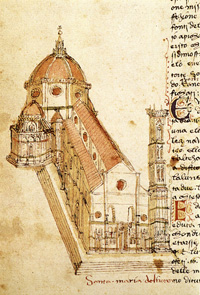
Santa Maria del Fiore, Codex Rustici, Florence, 1447, conserved in the Archepiscopal Seminary
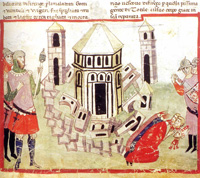 The Villani Chronicle, How the city of Florence was destroyed by Totila, the scourge of God, king of the Goths and Vandals, ms. Chigiano L VIII 296 della Biblioteca Vaticana, f.36r (1.III,1) The Villani Chronicle, How the city of Florence was destroyed by Totila, the scourge of God, king of the Goths and Vandals, ms. Chigiano L VIII 296 della Biblioteca Vaticana, f.36r (1.III,1)
|
In 1401, a competition was announced by the Arte di Calimala (Cloth Importers Guild) to design doors which would eventually be placed on the north side of the baptistry. (The original location for these doors was the east side of the baptistry, but the doors were moved to the north side of the baptistry after Ghiberti completed his second commission, known as the "Gates of Paradise.")[6]
These north doors would serve as a votive offering to celebrate the sparing of Florence from relatively recent scourges such as the Black Death in 1348. Many artists competed for this commission and a jury selected seven semifinalists. These finalists include Lorenzo Ghiberti, Filippo Brunelleschi, Donatello and Jacopo della Quercia,[7] with 21-year old Ghiberti winning the commission. At the time of judging, only Ghiberti and Brunelleschi were finalists, and when the judges could not decide, they were assigned to work together on them. Brunelleschi's pride got in the way, and he went to Rome to study architecture leaving Ghiberti to work on the doors himself. Ghiberti's autobiography, however, claimed that he had won, "without a single dissenting voice." The original designs of The Sacrifice of Isaac by Ghiberti and Brunelleschi are on display in the museum of the Bargello.
It took Ghiberti 21 years to complete these doors. These gilded bronze doors consist of twenty-eight panels, with twenty panels depicting the life of Christ from the New Testament. The eight lower panels show the four evangelists and the Church Fathers Saint Ambrose, Saint Jerome, Saint Gregory and Saint Augustine. The panels are surrounded by a framework of foliage in the door case and gilded busts of prophets and sibyls at the intersections of the panels. Originally installed on the east side, in place of Pisano's doors, they were later moved to the north side. They are described by the art historian Antonio Paolucci (it) as "the most important event in the history of Florentine art in the first quarter of the 15th century".[8]
|
|
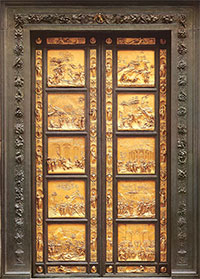
East doors, or Gates of Paradise, by Lorenzo Ghibertiadise, by Lorenzo Ghiberti |
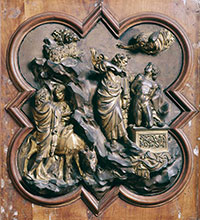 |
|
 |
|
Each panel of the Gates of Paradise depicts several episodes of a biblical narrative. This panel depicts the story of Cain and Abel: Adam and Eve before their tent, Abel guarding the herd, the sacrifices of Cain and Abel, Cain killing Abel, God banishing Cain. |
| Ghiberti, Sacrifice of Isaac, 1401-3 |
|
Brunelleschi, Sacrifice of Isaac, 1401-3
|
|
|
Gates of Paradise | Lorenzo Ghiberti, Story of Abel and Cain
|
|
|
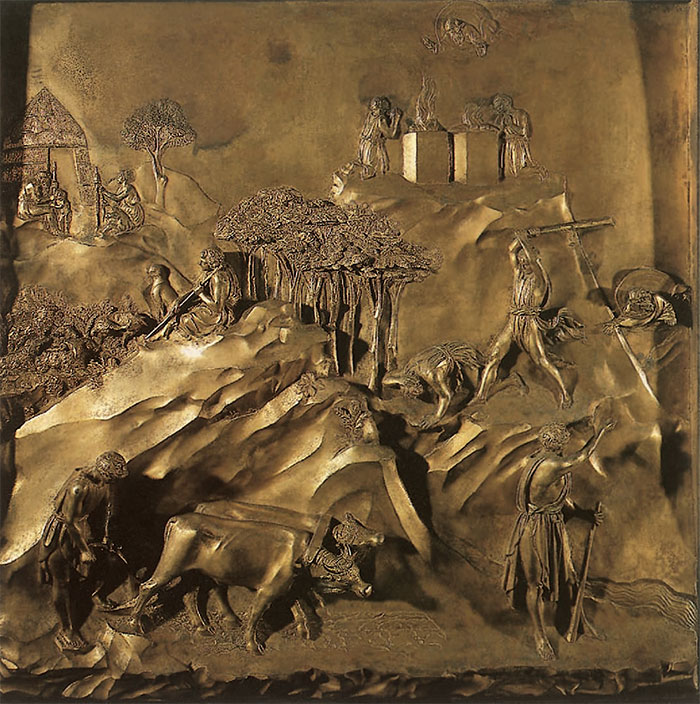 |
Lorenzo Ghiberti, Story of Abel and Cain (original panel of the eastern Door of Eden, baptistery of Florence), 1425-1437.
Gilded bronze, 79.5 x 79.5 cm, Museo dell’Opera del Duomo, Florence.
|
The bronze statues over the northern gate depict John the Baptist preaching to a Pharisee and Sadducee. They were sculpted by Francesco Rustici and are superior to any sculpture he did before. Rustici may have been aided in his design by Leonardo da Vinci, who assisted him in the choice of his tools.
Ghiberti was now widely recognized as a celebrity and the top artist in this field. He was showered with commissions, even from the pope. In 1425 he got a second commission, this time for the east doors of the baptistry, on which he and his workshop (including Michelozzo and Benozzo Gozzoli) toiled for 27 years, excelling themselves. These had ten panels depicting scenes from the Old Testament, and were in turn installed on the east side. The panels are large rectangles and are no longer embedded in the traditional Gothic quatrefoil, as in the previous doors. Ghiberti employed the recently discovered principles of perspective to give depth to his compositions. Each panel depicts more than one episode. In "The Story of Joseph" is portrayed the narrative scheme of Joseph Cast by His Brethren into the Well, Joseph Sold to the Merchants, The merchants delivering Joseph to the pharaoh, Joseph Interpreting the Pharaoh's dream, The Pharaoh Paying him Honour, Jacob Sends His Sons to Egypt and Joseph Recognizes His Brothers and Returns Home. According to Vasari's Lives, this panel was the most difficult and also the most beautiful. The figures are distributed in very low relief in a perspective space (a technique invented by Donatello and called rilievo schiacciato, which literally means "flattened relief".) Ghiberti uses different sculptural techniques, from incised lines to almost free-standing figure sculpture, within the panels, further accentuating the sense of space.
The panels are included in a richly decorated gilt framework of foliage and fruit, many statuettes of prophets and 24 busts. The two central busts are portraits of the artist and of his father, Bartolomeo Ghiberti.
Although the overall quality of the casting is exquisite, some mistakes have been made. For example, in panel 15 of the north doors (Flagellation) the casting of the second column in the front row has been mistakenly overlaid over an arm, so that one of the flagellators looks trapped in stone, with his hand sticking out of it.[9]
Michelangelo referred to these doors as fit to be the "Gates of Paradise" (It. Porte del Paradiso), and they are still invariably referred to by this name. Giorgio Vasari described them a century later as "undeniably perfect in every way and must rank as the finest masterpiece ever created". Ghiberti himself said they were "the most singular work that I have ever made".
Preservation of original art
|
|
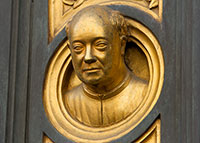 Self portrait of the artist, Lorenzo Ghiberti, on the "Gates of Paradise," gilded bronze, 1425-52. Self portrait of the artist, Lorenzo Ghiberti, on the "Gates of Paradise," gilded bronze, 1425-52.
|
The "Gates of Paradise" situated in the Baptistry are a copy of the originals, substituted in 1990 to preserve the panels after over five hundred years of exposure and damage. To protect the original panels for the future, the panels are being restored and kept in a dry environment in the Museo dell'Opera del Duomo, the museum of the Duomo's art and sculpture. Some of the original panels are on view in the museum; the remaining original panels are being restored and cleaned using lasers in lieu of potentially damaging chemical baths. Three original panels made a US tour in 2007-2008, and then were reunited in a frame and hermetically sealed with the intention of making the panels appear in the context of the doors for public viewing.[10] One of the few copies made in the 1940s is installed in Grace Cathedral, in San Francisco.
Other contributors
The two porphyry columns on each side of the Gates of Paradise were plundered by the Pisans in Majorca and given in gratitude to the Florentines in 1114 for protecting their city against Lucca while the Pisan fleet was conquering the island.
The Gates of Paradise are surmounted by a (copy of a) group of statues portraying the The Baptism of Christ by Andrea Sansovino. The originals are in the Museo dell'Opera del Duomo. He then left to Rome to work on a new commission, leaving these statues unfinished. Work on these statues was continued much later in 1569 by Vincenzo Danti, a sculptor from the school of Michelangelo. At his death in 1576 the group was almost finished. The group was finally completed with the addition of an angel by Innocenzo Spinazzi in 1792.
Panels
|
|
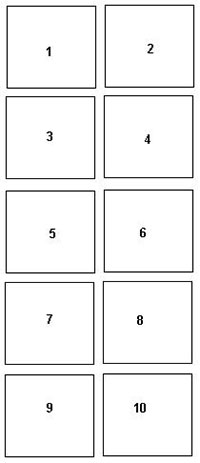
|
| |
|
East doors, the Gates of Paradise (Lorenzo Ghiberti) : 1. Adam and Eve 2. Cain and Abel 3. Noah 4. Abraham 5. Isaac with Esau and Jacob 6. Joseph 7. Moses 8. Joshua 9. David 10. Solomon and the Queen of Sheba.
|
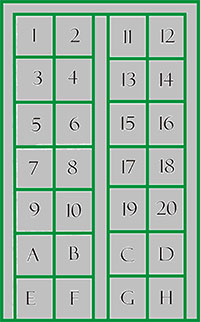 |
|
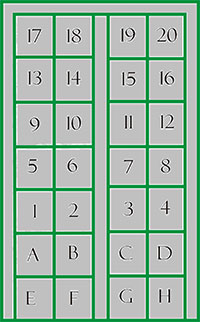
|
|
|
| South doors (Andrea Pisano) 1. The angel announces to Zachariah. 2. Zachariah is struck mute 3. Visitation 4. Birth of the Baptist. 5. Zachariah writes the boy's name. 6. St John as boy in the desert. 7. He preaches to the Pharisees. 8. He announces Christ. 9. Baptism of his disciples. 10. Baptism of Jesus. 11. St John reprimands Herod Antipas. 12. Incarceration of St. John. 13. The disciples visit St. John. 14. The disciples visit Jesus. 15. Dance of Salome. 16. Decapitation of St. John. 17. Presentation of St John's head to Herod Antipas. 18. Salome takes the head to Herodias 19. Transport of the body of St. John. 20. Burial. A. Hope B. Faith C. Charity D. Humility E. Fortitude F. Temperance G. Justice H. Prudence |
|
North doors (Lorenzo Ghiberti): 1. Annunciation. 2. Nativity. 3. Adoration of the magi. 4. Dispute with the doctors. 5. Baptism of Christ. 6. Temptation of Christ 7. Chasing the merchants from the Temple. 8. Jesus walking on water and saving Peter. 9. Transfiguration. 10. Resurrection of Lazarus. 11. Entry of Jesus in Jerusalem. 12. Last Supper. 13. Agony in the Garden. 14. Christ captured. 15. Flagellation. 16. Jesus before Pilate. 17. Ascent to Calvary. 18. Crucifixion. 19. Resurrection. 20. Pentecost. A. St. John Evangelist. B. St. Matthew C. St. Luke D. St. Mark E. St. Ambrose F. St. Jerome G. St. Gregory H. St. Augustine. |
|
|
Interior
|
|
|
The vast interior of the Baptistry recalls the interior of the Pantheon in Rome. The interior is rather dark, light entering through small windows in the ambulatory and through the lantern. The interior is divided in a lower part with columns and pilasters and an upper part with an ambulatory. The Florentines didn't spare any trouble or expense to decorate the baptistry. The interior walls are clad in dark green and white marble with inlaid geometrical patterns. The niches are separated by monolithic columns of Sardinian granite. The marble revetment of the interior was begun in the second half of the eleventh century.
The rectangular apse was faced with mosaics in 1225.
The building contains the monumental Tomb of Antipope John XXIII by Donatello and Michelozzo Michelozzi. A gilt statue, with the face turned to the spectator, reposes on a deathbed, supported by two lions, under a canopy of gilt drapery. He had bequeathed several relics and his great wealth to this baptistry. Such a monument with a baldachin was a first in the Renaissance.
The mosaic marble pavement was begun in 1209. The geometric patterns in the floor are complex. Some show us oriental zodiac motifs, such as the slab of the astrologer Strozzo Strozzi. There was an octagonal font, its base still clearly visible in the middle of the floor. This font, which once stood in the church of Santa Reparata, was installed here in 1128. Dante is said to have broken one of the lower basins while rescuing a child from drowning. The font was removed in 1571 on orders from the grand duke Francesco I de' Medici. The present, and much smaller, octagonal font stands near the south entrance. It was installed in 1658 but is probably much older. The reliefs are attributed to Andrea Pisano or his school.
Mosaic ceiling
|
|
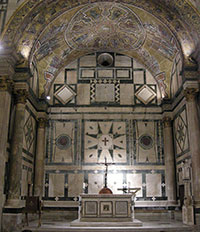
|
The Baptistry is crowned by a magnificent mosaic ceiling. The earliest mosaics, works of art of many unknown Venetian craftsmen (including probably Cimabue), date from 1225. The covering of the ceiling started under the direction of the Franciscan friar Jacopo Torriti and was probably not completed until the fourteenth century.
This mosaic cycle depicts in the three sections above the high altar, the Last Judgment with a gigantic, majestic Christ and the Angels of Judgment at each side by Coppo di Marcovaldo, the rewards of the saved leaving their tomb in joy (at Christ's right hand), and the punishments of the damned (at Christ's left hand). This last part is particularly famous: evil doers are burnt by fire, roasted on spits, crushed with stones, bit by snakes, gnawed and chewed by hideous beasts. These scenes remind us of later works showing us in grisly detail the horrors of hell, such as The Last Judgment or the panel Hell (from the triptych The Garden of Earthly Delights), both by the Flemish painter Hieronymus Bosch.
The other scenes on the ceiling depict different stories in horizontal tiers of mosaic : (starting at the top) Choirs of Angels, Thrones, Dominations, and Powers; stories from the Book of Genesis; stories of Joseph; stories of Mary and the Christ and finally in the lower tier : stories of Saint John the Baptist.
In the drum under the ceiling are many heads of prophets, attributed to Gaddo Gaddi, a friend of Cimabue.
|
|
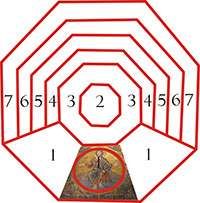
Plan of the mosaic ceiling : 1. Last Judgment. 2. Lantern. 3. Choirs of Angels. 4. Stories from the Book of Genesis. 5. Stories of Joseph. 6. Stories of Mary and Christ. 7. Stories of St. John the Baptist. |
| |
|
|
 |
| |
 |
|
|
| |
|
|
| |
|
|
|
|
| |
|
Florence, view on and the Baptistry |
|
|
[0] Victoria Charles, Renaissance Art, Parkstone Press International, New York, USA
'Lorenzo Ghiberti (born in Florence circa 1378 – died in Florence in 1455) The Italian sculptor Lorenzo Ghiberti learned the craft of gold work under his father Ugoccione and his stepfather Bartoluccio. During the first stage of his artistic career, Ghiberti was mainly known as a mural painter. He created a highly regarded fresco, for instance, in the palace of the local prince Pandolfo Malatesta.
When he learned that there was a competition for the designs of a second bronze portal for the baptistery, Ghiberti returned to Florence. The already decided subject was Isaac’s sacrifice, and the artists had to hand in designs at the same time, which matched the first bronze gate of the baptistery, created approximately 100 years before by Andrea Pisano. Six Italian artists submitted contributions to the competition, and Ghiberti’s was announced the best. Subsequently, Ghiberti was occupied for twenty years with the first of his two bronze portals for the baptistery.
Ghiberti tackled his task with a deep religious fervour, striving for a great poetic ideal, such as we do not find in Donatello’s work, for instance. The unlimited admiration, aroused by his first bronze door, induced the Florentine guilds to entrust him with a further portal, whose themes were also taken from the Old Testament. The Florentines were very proud of these magnificent works of art, which must have still been shining with all the brilliance of their original gold paint, when Michelangelo declared them worthy of serving as the gate to Paradise. Next to the doors of the baptistery are the three statues of John the Baptist, St Matthew and St Stephen in the church of Or San Michele, Ghiberti’s outstanding works of art, preserved until this day. He died at the age of seventy-seven.
We know more about Ghiberti’s theoretical ideas on art than about most of his contemporaries. He left us a commentary, which, apart from his thoughts on art, also told us a lot about his character and his personal convictions. Every page illustrates his deep religiosity, which characterised his life and work. He not only strives to proclaim the truth of his Christian belief in his work, but also sees a relationship to the classical Greek statues, which, according to him, express the highest intellectual and moral characteristics of human nature.'
[1] Florence and Central Italy, 1400–1600 A.D., Heilbrunn Timeline of Art History, The Metropolitan Museum of Art
[2] Dante Alighieri (1265-1321)
[3] Baptistry of Florence
[4] Villani, I.42.
[5] "Eight-Point Star (Star of Redemption) - cited 2011-05-21". Religionfacts.com.
[6] See Laurie Schneider Adams, Italian Renaissance Art, (Boulder, Colorado: Westview Press, 2001), 60. Actually, at the time of the 1401 competition the Florence baptistry needed two portals to be decorated. The aim of the 1401-02 competition was to begin work on this project. See also Monica Bowen, "Ghiberti's North Doors," from Alberti's Window, July 24, 2010
[7] The Premier Artists of the Italian Low Renaissance
[8] Antonio Paolucci (1996), "The Origins of Renaissance Art: The Baptistery Doors, Florence" 176 pages; Publisher: George Braziller; ISBN 080761413
[9] Julian Bell (2007). Mirror of the World: A New History of Art (1st paperback ed.). Thames & Hudson. p. 161. ISBN 978-0-500-28754-5. "It is noticeable nonetheless that the casting of one column has been mistakenly overlaid over a flagellator's arm, as it were trapping his hand."
[10] Carol Vogel, "One of Florence’s Renaissance Prizes to Go on U.S. Tour," New York Times, October 16, 2006. This article includes more detailed information concerning the restoration process, and discoveries concerning the creation of the panels in Ghiberti's workshop.
[11] "Brunelleschi & Ghiberti, The Sacrifice of Isaac". Smarthistory at Khan Academy. Retrieved January 6, 2013. |
|
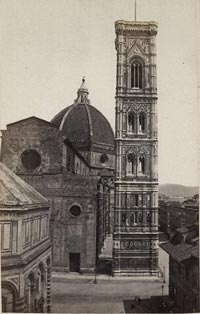
Giacomo Brogi (1822-1881) - "Florence. Giotto bell-tower". Ca. Before 1865
|
[12] Since their installation in 1452, the doors have withstood a variety of near-biblical catastrophes: a torrential flood, vandalism, overzealous polishing and caustic air pollution. When the doors were finally removed for restoration from the facade of the 11th-century octagonal Baptistery in 1990, they looked dull and grimy. But the worst damage was occurring almost invisibly. Diagnostic studies revealed that fluctuations in humidity were causing unstable oxides on the bronze beneath the gilding to dissolve and recrystallize, creating minute craters and blisters on the gold surface.
During WWII they were removed and hidden for safe keeping and, after the flood of 1966 which caused damage to the lower panels, they were removed and replaced by reproductions.
Additional reading
Wirtz, Rolf C. (2005). Kunst & Architectur, Florenz. Tandem verlag. ISBN.
Jepson, Tim. The National Geographic Traveler. Florence & Tuscany. National Geographic Society. ISBN.
Montrésor, Carlo (2000). The Opera del Duomo Museum in Florence. Mandragora.
Clark, Kenneth; David Finn. The Florence Baptistry Doors.
Radke, Gary. The Gates of Paradise: Lorenzo Ghiberti's Renaissance Masterpiece (High Museum of Art Series).
|
|
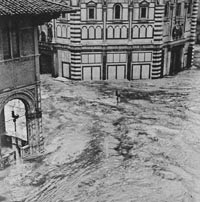 A disastrous Arno River flood in 1966 had knocked five panels off the door frames and left another hanging loose. A disastrous Arno River flood in 1966 had knocked five panels off the door frames and left another hanging loose.
View onto the Baptistery and the Loggia del Bigallo (Photographer Bazzechi) |
|

Located 350m above sea level and next to the ancient woods of Monte Amiata, Podere Santa Pia dominates the valley of the river Ombrone and the Maremma hills, with its famous olive trees and Montecucco vineyards. The panorama is extraordinary, silent, including the intense green of the fields at springtime, the golden yellow in summer and the brown in autumn interrupted by the evergreen of the mediterranian woods.
Tuscany is one of the most popular tourist destinations in the world. Known for its enchanting landscapes, its fantastic and genuine food and beautiful towns as Florence, Pisa, Lucca and Siena. The holiday farmhouse Poder eSanta Pia is located in Tuscany, halfway between Siena and Pitigliano, an area that is appreciated all over the world for its climate and the beauty of the hilly landscape, that enables visitors to spend a unique and relaxing holiday in the Italian countryside. The hills are clothed in Mediterranean bush
and mixed woodland, teaming with rare flowers, butterflies and game;
wonderful for long exploratory walks.
The hidden secrets of southern Tuscany | Podere Santa Pia
|
 |
|
| |
| |
|
|
|
|
|
|
![]()
![]()
![]()
![]()
![]()

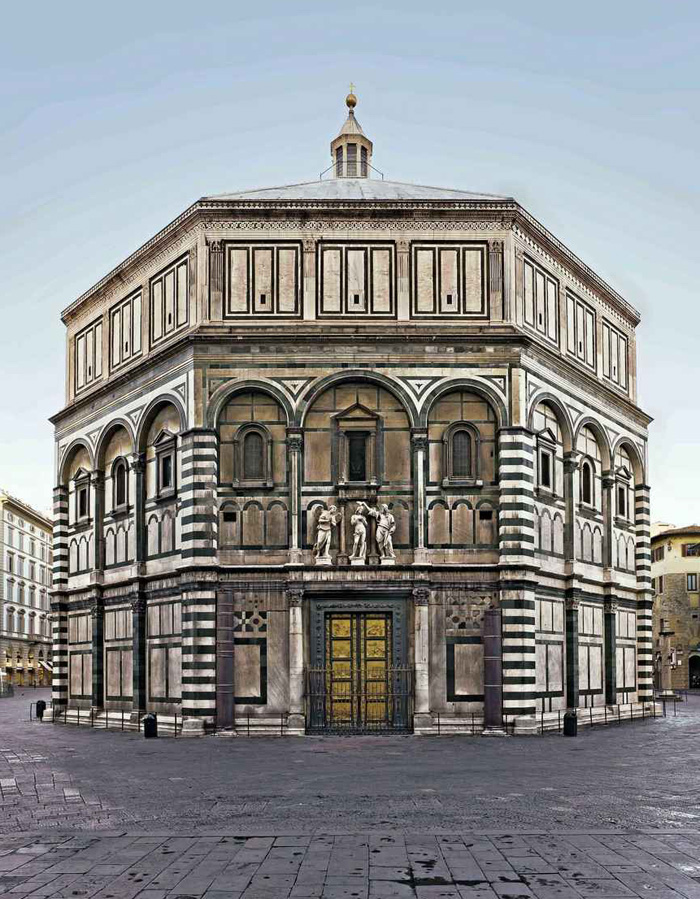







 Self portrait of the artist, Lorenzo Ghiberti, on the "Gates of Paradise," gilded bronze, 1425-52.
Self portrait of the artist, Lorenzo Ghiberti, on the "Gates of Paradise," gilded bronze, 1425-52. 







